
* First presented at the Altshuller Institute Conference "TRIZCON99" March 7-8, 1999
Steven F. Ungvari
Strategic Product Innovations, Inc.
TRIZCON99 March 7-9, 1999
Novi Michigan
Abstract
In the 1980s industries in North America and Europe experienced severe competitive pressures from Japanese manufacturers. The dramatic advantage in quality and productivity held by companies such as Toyota, Hitachi, Sharp and Sony resulted in a wholesale redistribution of market share from the US to Japan. What were some of the weapons in the Japanese arsenal? The widespread application of statistical and quality methods taught by Dr. W. Edwards Deming and Joseph Juran coupled with powerful techniques such as Quality Function Deployment, Robust Design Just-in-Time Manufacturing and Total Quality Management created advantages in cost, development cycle time, delivery time, and customer satisfaction.
Today, the quality, productivity and cost gap has narrowed considerably. As a result, the basis for competitive advantage has shifted to a new set of factors. The key strategies as the millennium approaches are: 1) An exceptional understanding of user values, 2) Time to market, 3) Innovation and 4) Product differentiation. TRIZ provides a powerful scientific set of competencies to leverage an organization's ability to compete successfully in the new paradigm.
Key Words
Complementary Assets, Dominant Design Paradigm, Line Extensions, New-to-the Company, Product Development Strategy, Protection Regimes, Technology Management.
Introduction
As the basis for competition has changed, the strategies to generate a defendable competitive advantage must likewise change. The dynamics of the marketplace demand a fresh approach to understanding customers, technology, and the internal processes utilized to design and develop new products. One common misconception in product development is that a First-to-Market strategy is more desirable than being second or third. Conventional wisdom is that companies that are first are innovators while companies that are second are imitators. Furthermore, conventional wisdom holds that innovation is always superior to imitation.
This paper challenges the notion that first to market, by definition, implies a company is innovative and in a superior competitive position. The historical record is, in fact, replete with successful second and third entrants as well as some that were first. The question to ponder is - How can an organization decide which strategy is best? The answer of course is - It depends. Depends on what? The key factors outlined to answer that question in the paper are: 1) The ability of an organization to protect its proprietary technology, 2) The Complementary Assets required in the field to support the new product, 3) The Dominant Design Paradigm, 4) Technology maturity, 5) Competitive position and 6) The degree of technology criticality.
The Need for New Product Development
A stream of new products is the future lifeblood of any organization. As product development cycles continue to shorten, companies must continually retool and improve their new product development (NPD) processes. Coupled to importance of efficiencies in the commercialization of technology, is the necessity for providing novel customer centric products. John Tyson, VP of Nortel summed up today's competitive imperative by stating "Superior design will always arise from the deep understanding of three fundamental user values: profound simplicity, conspicuous value and self-evidence."
The table below summarizes several quotes from recent business publications.
Quotes

Table 1.
Innovation Pays
There are several famous quotes from times past that shed light on the shortsightedness of some individuals regarding the appearance of new innovative technologies. Within the TRIZ lexicon this phenomenon is called Psychological Inertia (PI). See Table 2.
Famous Last Words

Table 2.
The book Winning New Product and Service Practices for the 1990s analyzed the revenue distribution of the best companies versus the rest. The financial yardstick was the amount of revenues received from products based on six categories. The six categories are: 1) New to the World, 2) New to Company, 3) Line Extensions, 4) Revisions, 5) Repositioned and 6) Cost Reduced products. The data unmistakably shows that the best companies have significantly higher revenues in the "New" categories while the rest are selling Revisions and Repositioned products. See Figure 1.

Figure 1.
Figures 2 and 3 show the impact that new products can have on growing the sales line, the bottom line and shareholder value.
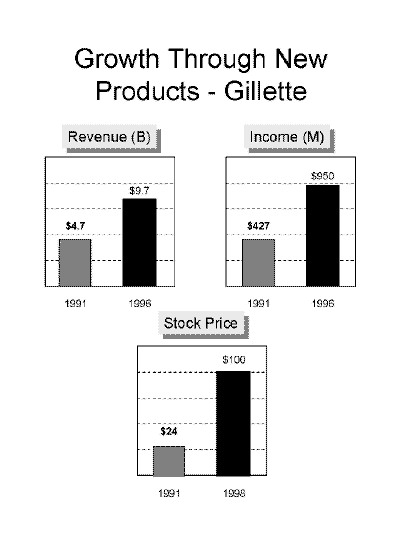
Figure 2.
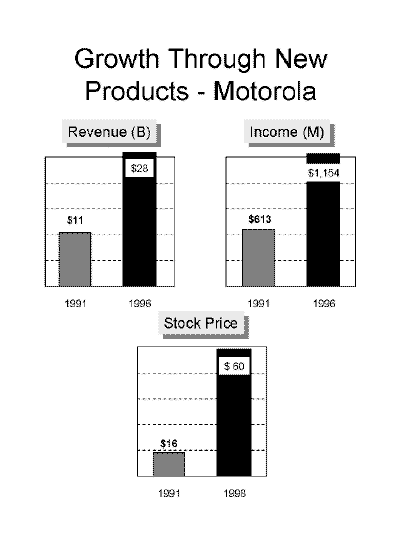
Figure 3.
The Elements of NPD
New product development is the future lifeblood of all organizations whether they are in the manufacturing or service sector. The best companies view NPD as the battleground where the viability of the organization is determined. The demands of the market place, the globalization of industry and ever more sophisticated and demanding customers are putting tremendous pressures on organizations to perform - flawlessly.
What should a "World Class" NPD system look like? The table below lists seven elements that should be part of every new product development system. See Table 3.
The Elements of "World Class" NPD

Table 3.
The Illustration below provides a pictorial representation of the integration and the interfaces of the seven elements. See Figure 4.
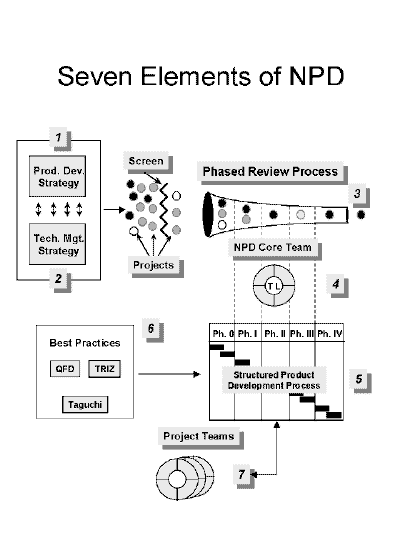
Figure 4.
Item number one in the architectural schematic above, Product Development Strategy, initiates the product development process and provides the long term rationale for which markets ant the type of products the company will develop. The new product development strategy itself is derived from a hierarchical set of inputs.
The inputs to product development strategy start at the top with a definition of the corporate long-term objectives. A component of long-term objectives is some articulation of how the corporation is going to grow the business. The growth objectives break down into the contribution to growth by new products which, in turn, gives rise to a new product development strategy. A subset to the product development strategy is the NPD differentiation strategy which, is the focus of this paper. The entire hierarchical decomposition is shown in Figure 5.

Figure 5.
New Product Development Strategy
Successful product development strategies are a result of leveraging three internal elements. The three elements are: 1) Technical advantages and experience, 2) Marketing savvy and 3) Better understanding of the customer. A working knowledge of TRIZ provides direct input into creating powerful technical advantages. This essentially accomplished by elimination of system contradictions and harmonizing the elements of the system. It can also be argued that application of Life Cycle "S" curve analysis provides insights into how products will evolve. This understanding can provide valuable glimpses into the future to assess potential customer reactions.
The options open to an organization can be divided into two basic strategic paths. The first is to introduce products that are similar to current offerings called "line extensions," or products that are "new-to-the company, or new-to-the world. Line extensions themselves can be further subdivided into four different types of extensions. The four are: 1) low-end (commodity) products, 2) next generation products, 3) breakthrough products and 4) high end products. The four options can be graphed on a two-axis plot correlating price to performance. See figure 6.
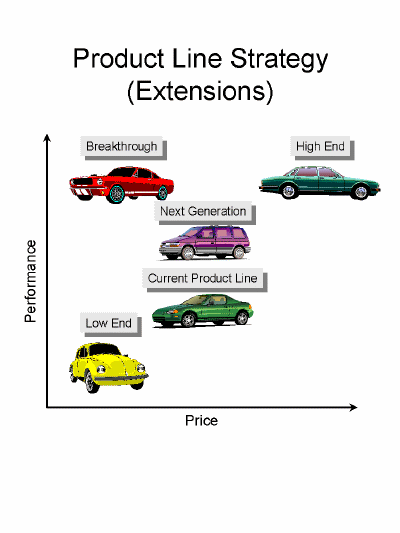
Figure 6.
How can TRIZ be a tool to assist in the task of deciding which strategy is right for the organization? The table below provides some possibilities. Note: the TRIZ techniques are not mutually exclusive.
Line Extension Strategies and TRIZ
| Product Strategy | TRIZ Techniques |
| Low End | Component/cost elimination through reassignment of
useful functions Increased manufacturing efficiencies through elimination of processing conflicts |
| Next Generation | Substance field models and standard solutions Elimination of Engineering Contradictions |
| Breakthrough | All of the above Technological Forecasting (S curve analysis) |
| High End | All of the above |
Table 4
The second product strategy option is to introduce new-to-the company or new-to-the world products. These types of products typically provide the greatest profit opportunities as well as the greatest risks for introducing cash draining "white elephants." All the more reason that one has to think through the strategic options available.
One of the critical decisions when introducing a new-to-"x" product is whether one should be first to market or a fast follower. To term it slightly differently whether to "innovate or imitate?" There is a natural seductive pull to being able to lay claim the competitive space by being the first to market. Is this always the best strategy? The answer is it depends on three critical factors i.e., the ability to protect proprietary knowledge, the emergence or non-emergence of the dominant design paradigm and the complementary product assets required to maintain the product in the field. Table 6 shows winners and losers in both innovator and imitator categories.
Winners and Losers
Innovator |
Imitator |
|
Winner |
Pilkington (Plate Glass) DuPont (Teflon) 3M (Post itTM) Apple (Macintosh) Chrysler (Minivan) |
IBM (PC) Matsushita (VHS) Seiko (Quartz Watch) Excel (Spreadsheet) Honda (Engines) |
Loser |
RC Cola (Diet Cola) EMI (Cat Scanner) Xerox ("Star" PC) Sony (Betamax) Tucker (Automobile) |
Kodak (Instant Photography) IBM (Early lap-top computers) DEC (PC) Cadillac (Small Seville) Northrop (F20) |
Table 5.
The three critical factors to weigh when considering whether to innovate or imitate include:
Definitions:
Protection regimes define the ability of an organization to protect its intellectual property. In some countries this can be accomplished through patent filings. Where patent laws are not respected, this obviously is a non sequitur. Even where patent laws are respected, some companies eschew them in favor of trade secrets i.e., the recipe for Coca-Cola syrup.
Dominant design paradigm defines a stage in the evolution in the product where a "standard' approach to the product emerges. For example, when Henry Ford built the moving assembly line, he defined the standard way to build and assemble cars (the dominant paradigm) which is still being followed today.
Complementary assets are any unique requirements of the product or the technology to ensure market viability. This could include specialized manufacturing or processing equipment, unique distribution channels or novel requirements for maintaining and servicing the product after it has been introduced.
Additional information on these critical factors is provided in figures 7,8,9.
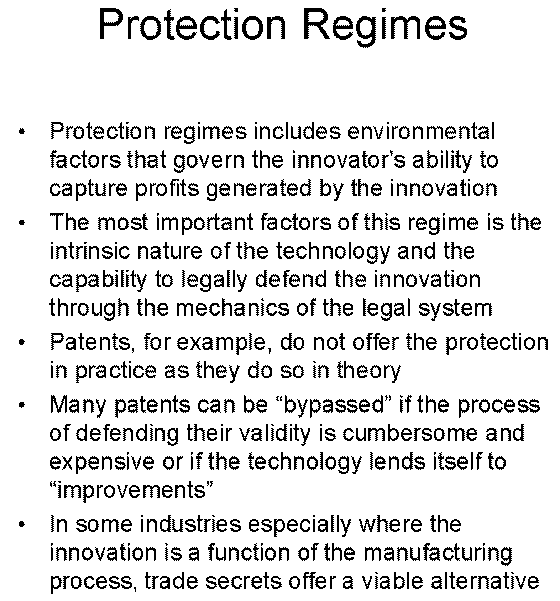
Figure 7.
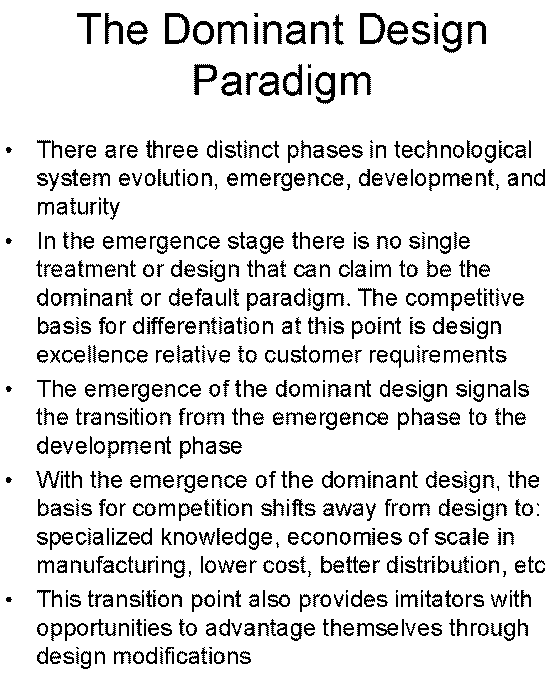
Figure 8.

Figure 9.
Development Strategies
If one assumes that the dominant design paradigm has manifested itself, then the two remaining factors can be evaluated on a two-axis plot to provide some guidance on whether to innovate or to imitate. See Figure 10.
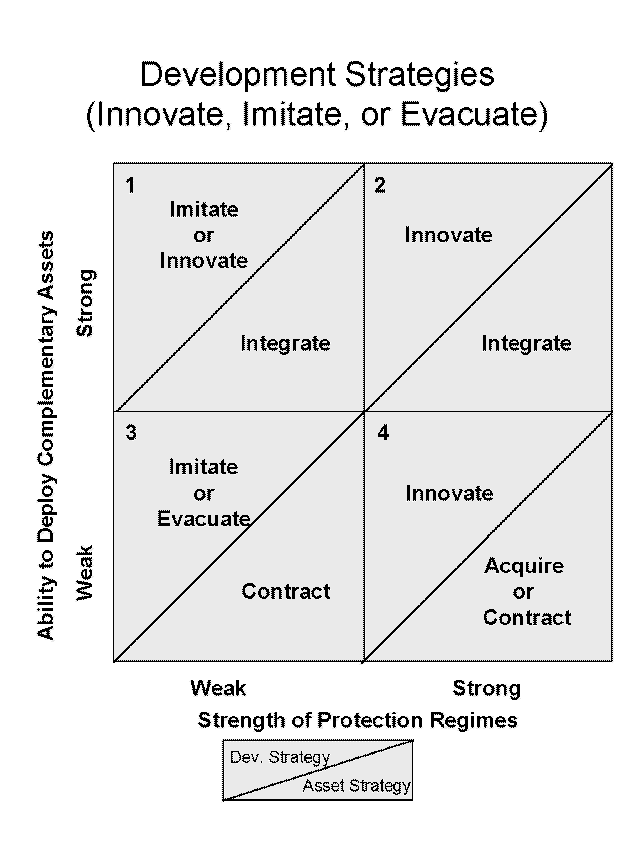
Figure 10.
The TRIZ Connection
Once an organization has made a rational decision on which product strategy to pursue from the logic plot shown on the previous page, the opportunities for utilization of TRIZ is obvious; at least to those who have a fundamentally sound understanding of the methodology. If the strategy is to be a "fast follower" or to imitate, the organization can leverage their product through the elimination of the inherent shortcomings of the original introduction. This is primarily a function of elimination of residual contradictions and improving the product to a degree that it is noticeable and significant.
If, however, logic dictates that innovative (first to market) products are the logical choice; TRIZ can provide solutions and concepts that are not limited by Psychological Inertia. Once an "out-of-the-box" solution is conceptualized, the various known laws of technological systems evolution provides an ability to create strategic patent umbrellas for a succession of line extensions and derivative products.
In Conclusion
Since its arrival to the US in the early 1990s, TRIZ has opened up a whole new way of thinking and approaching the full spectrum of product development issues. For line extension products that need to be differentiated, the powerful tools for component elimination, reassignment of functional requirements, and elimination of inherent system contradictions provides the TRIZ practitioner with enhanced product development capabilities.
For new-to-the world or new-to-the company products, TRIZ in conjunction with a rational strategic choice can be employed to create competitively superior and defendable products.
Acknowledgements
The author wishes to acknowledge The Altshuller Institute (AI) for creating a commercial free forum for the continued development and improvement of TRIZ. Special recognition and appreciation is due to Mr. Lev Shulyak for his vision and tireless persistence in getting this important organization off the ground. Several other individuals namely, Mr. Richard Langevin, Mr. John Terninko, Mr. Larry Smith, and Mr. Steve Rodman merit recognition in connection with the establishment of the institute. Ms. Ellen Domb and The TRIZ Journal were also very helpful in advertising and providing a boost to TRIZCON99.